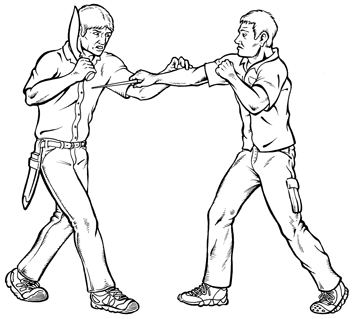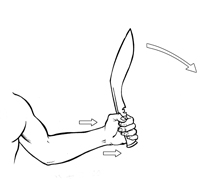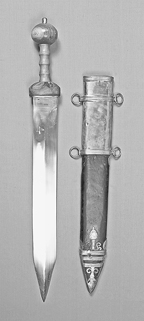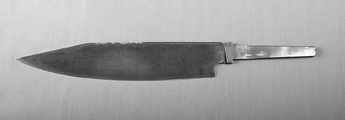Hank Reinhardt's Book of Knives: A Practical and Illustrated Guide to Knife Fighting (16 page)
Read Hank Reinhardt's Book of Knives: A Practical and Illustrated Guide to Knife Fighting Online
Authors: Hank Reinhardt


Thrusting with the kukri.
Now let’s talk about our training procedures: Again fill a large plastic soda bottle full of water, and practice until you can cut the top off just below the cap. Do this with a kukri and the Reinhardt Snap. Practice this until you can cut the top off without knocking the bottle over. Then we will try to cut slightly below that area, and cut through without knocking the bottle over. Cut at an angle. This holds the bottle to the surface and keeps it from falling over. This is also true when one tries to cut an opponent. It is a lot easier to cut “with the grain” and not against it.

Whit Williams cutting a water bottle.
Photo by Kevin Gravitt.
Now that you have worked on speed, it’s time to work on power. Take a one-inch piece of manila rope and hang it vertically. Practice until you can cut this piece. Practice safety at all times. Always wear eye protection and make sure no body part is out in front of your cut. Keep legs and hands out of the way. Remember, this is fighting, not ballet. Style note: no matter how much you scream it will not help you cut through this rope. It also will be a waste of time to have a “war face.” No matter how much you holler and frown, this piece of rope is still going to be tough to cut.
Once you have achieved one cut, try to make two fast ones on the same piece of rope. Once you have cut two pieces fast, it’s time to go on. Take two pieces of one-inch manila rope and tape them together at one-foot intervals. Tape them tightly. Now your target area will be the piece of tape holding the rope together. Cut through either the piece of tape or slightly above it. This is good practice for speed, accuracy, and power.
FIGHTING SITUATIONS
These practice techniques assume you will be standing up and able to maneuver. In this case, you face your adversary, flick out with the Reinhardt Snap


Flick out quickly with the Reinhardt Snap.
and cut your opponent across his hand or forearm. This should cause your opponent to lose control of his knife hand, enabling you to step back in and chop him across the carotid arteries on either side of his neck. This move must be done quickly, in and out with great speed, and never forgetting proper footwork.
You face your adversary, he thrusts at you. Using your superior footwork, you step back out of the way. As your opponent is fully extended in his thrust, you cut him across the brachial artery. (That’s the big artery on the inside of the arm, running from armpit to hand.)
Once again this must be timed perfectly. You need to watch the shoulder and arm of your opponent to make sure he is fully committed to a long thrust. If your opponent tries to cut you across the forearm or hand, step back out of range, and when he is fully extended, slash him across the forearm, then quickly skid up into the throat, severing his carotid arteries.
If your opponent tries to cut you across the carotid artery, bend down and get beneath the cut. Once again this needs to be practiced in sparring. As your opponent’s knife goes over your head, chop upward in a hard slashing cut, into the groin or the femoral artery, then immediately glide back out of the way using smooth and even footwork. This is extremely dangerous because you expose a lot of your body, but if properly practiced and executed it is hard to beat. The femoral artery lies just under the skin at the groin and is easy to sever. Also, a cut in the testicles causes painful discomfort. Most anybody chopped there will be ready to clock out and go home.
Keep in mind this works better if your adversary is the same height as you or taller. There’s too much danger if he is shorter than you, because you are exposed much longer to your opponent’s cuts. Quickly size up your opponent. If you are taller and have longer reach use these to your advantage. It’s not a good idea to close with a shorter man. But if you are shorter than your opponents, try to close the gap quickly and get inside his guard.
But say you face an opponent who has a hammer, piece of pipe or any similar striking instrument. As he raises the instrument above his head, flick the kukri out and cut him across the carotids. This move must be perfectly timed, and that takes practice. As the very instant he has his weapon over his head is when you must strike.
Now for some seated fighting situations. Say you are sitting in your automobile. An individual tries to force his way inside. There’s no room to swing or chop with a kukri in a car. Now take the edge of your kukri in a quick movement, and draw it back and forth across your assailant’s forearm in a sawing motion. This should make him yearn to turn loose of you or your steering wheel immediately. If he doesn’t, then give a short quick jab to his face with the point. Your aiming point is his nose or eyes. This should get the response you want. Then immediately drive off. Remember, your foe may have a friend nearby who could try to force his way into the passenger side.
As you have gathered by now, inside an automobile is a poor place to chop with a kukri. That’s where you need the knife’s inwardly curved edge to saw, and its point to stab. This is true, too, outside the car when an opponent closes with you and perhaps grabs your clothing. Use that inward curve to saw him across the neck, the inside of his thigh, behind his knee, and across the Achilles tendon of his ankle.
These are your basic moves for fighting with the kukri. You and your sparring partner should practice them until both are perfect in both maneuver and timing. Later you can add variations as you practice, in case your opponent comes up with surprise threats we have not mentioned. Remember fighting skills are like a pyramid. What I have given you here is just the base of the structure. The point of the pyramid is up to you and the only way you will get there is to practice these moves to improve speed and timing.
BOWIE KNIFE
The first time I ever saw a large Bowie knife, I was whittling an extremely hard piece of hickory into a spear. I had fire-hardened the point and was laboriously scraping it when Hank walked up and asked what I was doing. He looked at the point and said, “Let me see that.” And he started shaving it with his pocket knife. He looked up and said, “The hell with this. It’s taken the edge off my knife.” He disappeared into the house and returned with his Randall Smithsonian Bowie. In about ten seconds he managed to chop a very serviceable point on that hickory, which saved me a lot of work.
I had seen Bowie knives before in the windows of pawn shops, and of course who could forget the movie
Iron Mistress
? This was the very first time I had seen anything actually cut up with one. This knife is truly America’s gladius.

Reproduction gladius, 28 inches overall length.
HRC218
For this book, we’ll define a Bowie as a knife four inches or longer with a clip point and a sharpened top edge. The ability of this weapon as a tool of carnage is legendary. So much so, that it is still outlawed in many Southern states.

Blade by Jim Fikes, 14 inches overall length.
HRC647
Legend has it that the first Bowie knife was crafted about 1827, by an Arkansas blacksmith/knifesmith named James Black, according to the specifications of Alamo hero James Bowie. Legend insists that a Bowie knife had to be sharp enough for shaving, and heavy enough to use as a hatchet. It had to be long enough to be swung as a sword, and wide enough to paddle a canoe. This description might be slightly exaggerated, but there is no doubt the Bowie was a large knife with a blade sometimes fourteen to eighteen inches long. It was soon the object of tall tales and legends from Virginia to Texas.
As with the kukri, as repeating weapons proliferated, the knife became a secondary weapon and got smaller in size.

